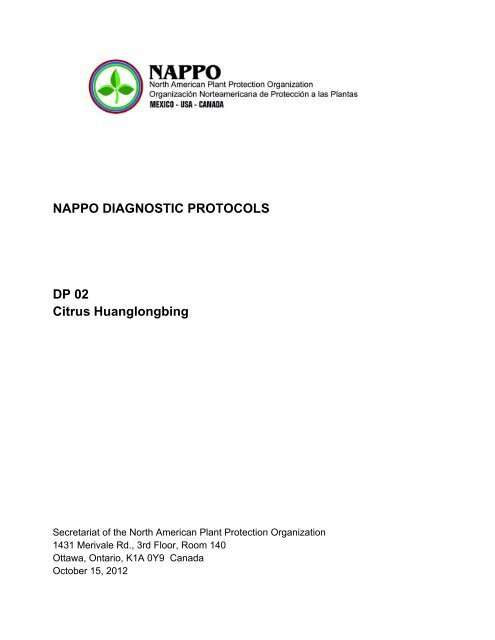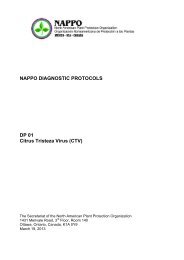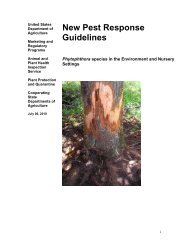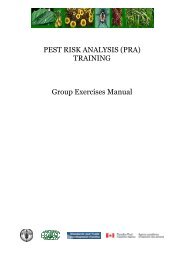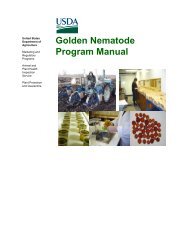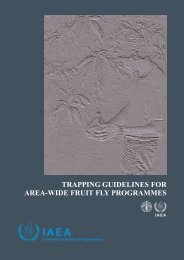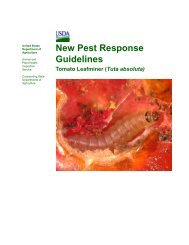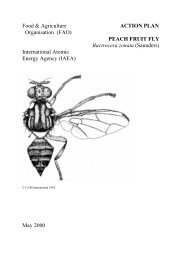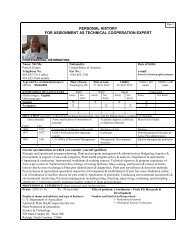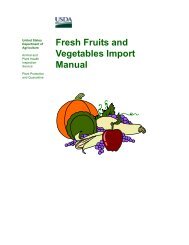NAPPO DIAGNOSTIC PROTOCOLS DP 02 Citrus Huanglongbing
NAPPO DIAGNOSTIC PROTOCOLS DP 02 Citrus Huanglongbing
NAPPO DIAGNOSTIC PROTOCOLS DP 02 Citrus Huanglongbing
You also want an ePaper? Increase the reach of your titles
YUMPU automatically turns print PDFs into web optimized ePapers that Google loves.
<strong>NAPPO</strong> <strong>DIAGNOSTIC</strong> <strong>PROTOCOLS</strong><br />
<strong>DP</strong> <strong>02</strong><br />
<strong>Citrus</strong> <strong>Huanglongbing</strong><br />
Secretariat of the North American Plant Protection Organization<br />
1431 Merivale Rd., 3rd Floor, Room 140<br />
Ottawa, Ontario, K1A 0Y9 Canada<br />
October 15, 2012
Contents<br />
Page<br />
Review ..........................................................................................................................3<br />
Approval ........................................................................................................................3<br />
Implementation.............................................................................................................. 3<br />
Amendment Record ...................................................................................................... 3<br />
Distribution ....................................................................................................................3<br />
1. Pest Information.................................................................................................. 4<br />
2. Taxonomic Information ....................................................................................... 4<br />
3. Detection ............................................................................................................ 5<br />
4. Identification........................................................................................................ 6<br />
4.1 Molecular diagnostics ......................................................................................... 6<br />
4.2 Biological indexing .............................................................................................. 7<br />
5. Sampling of propagative material ....................................................................... 7<br />
6. Records .............................................................................................................. 8<br />
7. Points of contact for additional information ......................................................... 8<br />
8. Acknowledgements............................................................................................. 9<br />
9. References ......................................................................................................... 9<br />
<strong>DP</strong> <strong>02</strong><br />
<strong>Citrus</strong> <strong>Huanglongbing</strong><br />
2
1. Pest Information<br />
<strong>Citrus</strong> huanglongbing (HLB), also known as <strong>Citrus</strong> Greening (da Graça and Korsten,<br />
2004), is one of the most serious diseases that affect citrus worldwide (Halbert, 1998). It is<br />
associated with the bacteria Candidatus Liberibacter spp., a fastidious bacterium that<br />
resides in infected psyllids and in the elements of the phloem sieve tubes of infected<br />
plants.<br />
It has been difficult to detect the bacteria in a consistent manner by biological assay<br />
(Roistacher, 1991), by the presence of fluorescent substances, light or electronic<br />
microscopy, or serologically, due to the low concentration and irregular distribution of the<br />
pathogen in host plants and insect vectors.<br />
HLB was detected in 2004 in Sao Paulo, Brazil, in the Araraquara region (Coletta et al.,<br />
2004). In September of 2005, its presence was confirmed in Florida, in 2006 it was<br />
detected in Cuba, and in 2008 in Louisiana, Georgia, and South Carolina (USA) (<strong>NAPPO</strong>,<br />
n.d.). In 2009, the bacterium was detected in the state of Yucatan, Mexico, representing<br />
an imminent risk for Mexican citriculture as the psyllid vector (Diaphorina citri Kuwayama<br />
of the American and Asian strains) is present in all citrus-producing states of Mexico. HLB<br />
has also since been reported from the States of Quintana Roo, Nayarit, Jalisco,<br />
Campeche, Colima, Sinaloa, Michoacán, Chiapas, Hidalgo, and Baja California Sur. In<br />
2012, HLB was detected in Texas (Texas Department of Agriculture, 2012) and in Los<br />
Angeles County, California (USA) (CDFA, 2012).<br />
2. Taxonomic Information<br />
During the 13 th Congress of the International Organization of <strong>Citrus</strong> Virologists in Fuzhou,<br />
China, in 1995, the delegates adopted “<strong>Huanglongbing</strong>” (HLB) as the official name of the<br />
disease in honor of Professor Lin Kongxiang (Kung Hsiang) (da Graça et al, 1996). In<br />
Chinese, this means “yellow shoot disease”. It is also known as “Greening” in Africa and<br />
the United States (also translated into other European languages), “likubin” in Taiwan,<br />
“phloem vein degeneration” in Indonesia, “mottle leaf” in the Philippines, and “citrus<br />
dieback” in India (Bové, 2006).<br />
The causal agent apparently associated consistently with the symptoms of HLB is a gram<br />
negative, phloem-limited bacterium belonging to the alpha subdivision of the<br />
proteobacteria (Jagoueix et al., 1994). Electron microscopy has revealed elongated rodlike<br />
bacteria residing in the sieve tubes of infected plants. Since the bacterium has not<br />
been isolated and Koch’s postulates have not been fulfilled, the bacterium so far is called<br />
“Candidatus Liberibacter asiaticus’, “Ca. L. africanus, or Ca. L. americanus” in accordance<br />
with the International Journal for Systematic & Evolutionary Microbiology (IJSEM, 2012).<br />
<strong>DP</strong> <strong>02</strong><br />
<strong>Citrus</strong> <strong>Huanglongbing</strong><br />
4
In nature, HLB exists in three forms that differ in their pathogenicity due to a combination<br />
of environmental conditions and insect vectors (Jagoueix et al., 1996). These are:<br />
• Candidatus Liberibacter asiaticus Garnier (Las)<br />
• Candidatus Liberibacter africanus Garnier (Laf)<br />
• Candidatus Liberibacter americanus Texeira et al. 2005 (Lam)<br />
The African strain of HLB is heat sensitive and does not cause symptoms at temperatures<br />
greater than 25 – 30 ºC. The Asian strain is primarily distributed in Asia and was recently<br />
introduced into the Western Hemisphere some time in the late 1990’s or early 2000’s. It is<br />
heat tolerant and able to cause symptoms at temperatures greater than 30 ºC (Bové and<br />
Garnier, 20<strong>02</strong>; Bové, 2006). The American strain, which was reported from Brazil, appears<br />
to have heat tolerance similar to that of the African strain (Lopes et al., 2009).<br />
3. Detection<br />
HLB is a disease that affects the entire plant. Symptom expression in general is delayed<br />
several months after the plant becomes infected. The initial symptom is yellowing of the<br />
leaves on some branches in contrast with the green of the rest of the plant. This is most<br />
evident during fall and winter, when intense yellowing and mottling is observed (Bové,<br />
2006).<br />
In leaves, a pale yellow colouration with irregular (asymmetrical) areas of green colour<br />
(mottling) is observed (Figure 1), with enlargement and clearing of the veins, which after a<br />
time retain a corky aspect. Different levels of defoliation may occur. Diffusion of colors in<br />
the veins and blades is observed, which can be confused with mineral deficiencies (zinc<br />
and copper) (Colletta-Filho et al., 2004).<br />
In branches, when the disease has evolved, there is an intense defoliation. The<br />
symptoms can appear in the entire crown and the trees can dry out and die. In fruit,<br />
deformation and asymmetry are observed, along with reduced size, and the appearance of<br />
areas of clear green colour that contrast with the normal yellow or orange of the fruit.<br />
Internally, there are differences in maturation and seed abortion (Figure 2), misalignment<br />
of the axis and in some cases, the white portion of the skin (albedo) shows a larger than<br />
normal thickness (Bové, 2006).<br />
<strong>DP</strong> <strong>02</strong><br />
<strong>Citrus</strong> <strong>Huanglongbing</strong><br />
5
Figure 1. Asymmetrical mottling, typical symptoms of<br />
HLB. Photo: Iobana Alanís<br />
Figure 2. Deformation of fruit and seed abortion.<br />
Photo: Pedro Robles<br />
4. Identification<br />
4.1 Molecular diagnostics<br />
For the diagnosis of HLB, two techniques have been used: conventional Polymerase<br />
Chain Reaction (PCR) and real time PCR (PCR-RT, also known as quantitative PCR =<br />
qPCR) that are based on the use of PCR primers that amplify DNA sequences of the<br />
Liberibacters associated with HLB. Conventional PCR methods use specific primers that<br />
amplify the sequences of the rDNA 16s genes and primers based on the proteinaceous<br />
genes (operon-B) (Jagoueix et al., 1996; Tian et al., 1996; Hocquellet et al., 1999, Teixeira<br />
et al., 2005). The low concentration and irregular distribution of the pathogen in host<br />
plants, along with the inhibitors of PCR present in citrus extracts, have made detection of<br />
the pathogen difficult. Although conventional PCR and qPCR are accepted techniques for<br />
the confirmation of trees symptomatic for HLB in Brazil and the United States, qPCR is<br />
much more sensitive and robust than conventional PCR and the technique has been<br />
validated with DNA extracts from different species of citrus and different tissues from<br />
diverse geographic regions. The currently accepted qPCR technique was developed by Li<br />
and associates (Li et al., 2006, 2007).<br />
The <strong>NAPPO</strong> member countries approve for use the following protocols developed by<br />
USDA-APHIS-PPQ-CPHST:<br />
1) “Plant sample extraction for use in citrus greening or huanglongbing molecular<br />
diagnostic assays”, and<br />
2) “Real-time PCR for diagnostic detection of citrus greening or huanglongbing from plant<br />
samples”.<br />
<strong>DP</strong> <strong>02</strong><br />
<strong>Citrus</strong> <strong>Huanglongbing</strong><br />
6
These protocols are available in the chapter “DNA extraction and PCR detection in citrus”<br />
of the document “New Pest Response Guidelines – <strong>Citrus</strong> Greening<br />
(http://www.aphis.usda.gov/plant_health/plant_pest_info/citrus_greening/downloads/pdf_fil<br />
es/cg-nprg.pdf). Additional to the protocols mentioned, confirmation of HLB by<br />
conventional PCR using the primers Ol1-Ol2c (Jagoueix et al., 1996), A2-J5 (Hocquellet et<br />
al., 1999) for the Asian and African strains and primers GB1-GB3 (Teixeira et al., 2005) for<br />
the American strain is recommended. Sequencing of the amplified fragments is also<br />
recommended.<br />
4.2 Biological indexing<br />
Although qPCR is currently the method of choice for diagnosis of HLB in planta, biological<br />
indexing techniques are also available and will be briefly summarized. Due to the<br />
sometimes low rate of graft transmission of the bacterium associated with HLB, the<br />
success rate for biological indexing or HLB is variable. The appropriate indicator plants are<br />
sweet orange or Orlando tangelo for African HLB and sweet orange or Ponkan mandarin<br />
for Asian HLB. Presence of the citrus tristeza virus can interfere with HLB symptom<br />
expression and if CTV is present, grapefruit may be used as an indicator. The preferred<br />
inoculation technique is the side graft, with leaf grafts being the alternative. The seedling<br />
indicators are trained to single leaders and held at 20 – 25 ºC for African HLB and 25 – 32<br />
ºC for Asian HLB. Symptom expression is the typical mottle and chlorosis. The shoots are<br />
distinctly smaller, more chlorotic, and with smaller leaves than the uninoculated controls.<br />
Symptoms should appear 8 to 12 weeks after inoculation. For more information on<br />
biological indexing in general and for HLB in particular, see Roistacher (1991) or<br />
Roistacher (1998).<br />
5. Sampling of propagative material<br />
Because distribution of Liberibacters may be irregular in the host plants and psyllid vector<br />
or have a very low incidence and titer, the sampling method is critical for the detection,<br />
identification and quantification of Liberibacter. In symptomatic trees, samples are taken<br />
from 1 – 4 branches with symptomatic leaves or fruit. If symptoms are not present in a<br />
suspect tree, samples are taken from one year-old branches with 5 – 10 leaves from the<br />
upper portion of each of the four quadrants of the tree. If branches are not present, as in<br />
the case of small nursery trees, 1 – 12 mature leaves are taken from each tree (Li et al.,<br />
2009). Before and during shipment of the samples to be analyzed, they should be<br />
protected from heat to prevent the possible degradation of pathogen DNA.<br />
The periodic exploration and sampling of the different production units of propagative<br />
material are fundamental for timely detection of HLB. It is important to indicate that these<br />
production units should be protected (under screen) and preferably removed from citrus<br />
production areas. The following visual and molecular diagnostic activities are<br />
7<br />
<strong>DP</strong> <strong>02</strong><br />
<strong>Citrus</strong> <strong>Huanglongbing</strong>
ecommended.<br />
Unit Molecular diagnostic (qPCR) Visual diagnostic<br />
Germplasm bank 100 % individual annual 100 % every 3 months<br />
Foundation block 100 % individual annual 100 % every 3 months<br />
Increase block<br />
Seed producing<br />
block<br />
Nursery<br />
6. Records<br />
10 % annual, composite sample from<br />
5 plants<br />
25 % individual annual, rotational to<br />
cover 100 % of the block in 4 years<br />
2 % of the total of all plants to be<br />
moved<br />
100 % every month<br />
100 % every month<br />
100% every month<br />
A registry of samples analyzed for HLB diagnostics should be maintained, which should<br />
contain:<br />
• Code or reference number of the sample.<br />
• Variety and origin of the sample.<br />
• Description of symptoms (including photographs, if pertinent) or absence of these.<br />
• Methods used in the diagnostic and the results obtained.<br />
• Name of the laboratory and when available, name of the persons responsible for the<br />
diagnostics.<br />
The registry and the evidence of the results of the diagnostics should be retained for at<br />
least four years with the goal of tracing the results in the different production units such as<br />
the germplasm bank and the seed producing orchard.<br />
7. Points of contact for additional information<br />
Centro Nacional de Referencia Fitosanitaria. Dirección General de Sanidad Vegetal.<br />
Guillermo Pérez Valenzuela No. 127 Col. Del Carmen, Coyoacán, Del. Coyoacán, México,<br />
DF 04100.<br />
<strong>Citrus</strong> Clonal Protection Program, Department of Plant Pathology, University of California,<br />
Riverside, CA 92521, USA.<br />
USDA-ARS National Clonal Germplasm Repository for <strong>Citrus</strong> & Dates, 1060 Martin Luther<br />
King Blvd., Riverside, CA 92507, USA.<br />
<strong>DP</strong> <strong>02</strong><br />
<strong>Citrus</strong> <strong>Huanglongbing</strong><br />
8
8. Acknowledgements<br />
Wenbin Li and Laurene Levy. National Plant Germplasm and Biotechnology Laboratory<br />
USDA-APHIS-PPQ-CPHST, Beltsville, MD 20705, United States.<br />
Robert Krueger. USDA-ARS National Clonal Germplasm Repository for <strong>Citrus</strong> & Dates,<br />
1060 Martin Luther King Blvd., Riverside, CA 92507, USA.<br />
Georgios Vidalakis. <strong>Citrus</strong> Clonal Protection Program, Department of Plant Pathology,<br />
University of California, Riverside, CA 92521, USA.<br />
Elena Iobana Alanís Martinez. Estación Nacional de Epidemiología, Cuarentena y<br />
Saneamiento Vegetal. SENASICA. Rancho G. B. Km. 21 Carretera Amazcala –<br />
Chichimequillas. El Marques, Querétaro.<br />
9. References<br />
Bové, J.M. 2006. <strong>Huanglongbing</strong>: a destructive, newly-emerging, century-old disease of<br />
citrus. Journal of Plant Pathology 88:7-37.<br />
Bové, J.M and M.Garnier. 20<strong>02</strong>. Phloem- and xylem-restricted plant pathogenic bacteria.<br />
Plant Science 163:1083-1098.<br />
CDFA. 2012.<br />
http://www.cdfa.ca.gov/egov/Press_Releases/Press_Release.asp?PRnum=12-012<br />
Coletta-Filho, M. L., P. N. Targon, M. A. Takita, J. D. De Negri, J. Pompeu Jr., M. A.<br />
Machado, A. M. do Amaral and G. W. Muller. 2004. Plant Disease 88:12, 1382-1382. First<br />
Report of the Causal Agent of <strong>Huanglongbing</strong> (“Candidatus Liberibacter asiaticus”) in<br />
Brazil<br />
da Graça, J.V and L. Korsten. 2004. <strong>Citrus</strong> huanglongbing: review, present status and<br />
future strategies. Pp 229-245 in: SAMH Naqvi (ed). Diseases of Fruits and Vegetables. Vol<br />
I. Kluwer.<br />
Halbert S.E. 1998. Entomology Section. Tri-ology (May-June 1998) 37 (3): 6-7<br />
Hocquellet, A., P.Toorawa, J.M. Bove and M. Garnier. 1999. Detection and identification of<br />
the two Candidatus Liberobacter species associated with citrus huanglongbing by PCR<br />
amplification of ribosomal protein genes of the h operon. Mol. Cell. Probes 13, 373-379.<br />
International Journal of Systematic & Evolutionary Microbiology (IJSEM) 2012. Some<br />
names included in the category Candidatus. J.P. Euzéby: List of Prokaryotic names with<br />
Standing in Nomenclature. http://www.bacterio.cict.fr/candidatus.html Last accessed June<br />
21, 2012.<br />
<strong>DP</strong> <strong>02</strong><br />
<strong>Citrus</strong> <strong>Huanglongbing</strong><br />
9
Jagoueix, S., J.M., Bové and M. Garnier.1994. The phloem-limited bacterium of greening<br />
disease of citrus is a member of the α subdivision of the Proteobacteria. Int. J. Syst.<br />
Bacteriol. 44(3):379-386.<br />
Jagoueix, S., J.M., Bové and M. Garnier. 1996. PCR detection of the two ‘Candidatus’<br />
Liberobacter species associated with greening disease of citrus. Mol. Cell. Probes 10, 43–<br />
50.<br />
Li, W.B., J.S. Hartung and L. Levy. 2006. Quantitative real-time PCR for detection and<br />
identification of Candidatus Liberibacter species associated with citrus huanglongbing.<br />
[PCR cuantitativa en tiempo real para detectar e identificar candidatos de especies de<br />
Liberibacter asociadas con el citrus huanglongbing] J. Microbiol. Methods 66:104-115.<br />
Li, W.B., J.S. Hartung and L. Levy. 2007. Evaluation of DNA amplification methods for<br />
improved detection of “Candidatus Liberibacter species” associated with citrus<br />
huanglongbing. Plant Disease 91:51-58.<br />
Li W. and Levy L. 2009. <strong>Citrus</strong> huanglongbing diagnosis based on molecular detection of<br />
associated liberibacter species.<br />
http://www.calcitrusquality.org/wp-content/uploads/2009/05/manuscript.pdf<br />
Lopes, S.A., G. F. Frare, E. Bertolini, M. Cambra, N. G. Fernandes, A. J. Ayres, D. R.<br />
Marin and J. M. Bové. 2009. Liberibacters associated with citrus huanglongbing in Brazil:<br />
'Candidatus Liberibacter asiaticus' is heat tolerant, 'Ca L americanus' is heat sensitive.<br />
Plant Dis 93:257-262.<br />
<strong>NAPPO</strong>. N.d. http://www.pestalaert.org<br />
Roistacher, C.N. 1991. Graft-Transmissible Diseases of <strong>Citrus</strong>. Handbook for detection<br />
and diagnosis. Rome: FAO. 280 pp.<br />
Roistacher, C.N. 1998. Indexing for viruses in citrus. Pp 301-319 in: A Hadidi, RK<br />
Khetarpal, H Koganezawa, eds. Plant Virus Disease Control. St Paul: APS Press.<br />
Texas Department of Agriculture. 2012.<br />
http://www.texasagriculture.gov/NewsEvents/NewsEventsDetails/tabid/76/Article/18<strong>02</strong>/tex<br />
as-department-of-agriculture-and-usda-confirm-detection-of-plant-disease-tha.aspx<br />
Texeira, DC, J. Ayres, E. W. Kitajima, L. Danet, S. Jagoueix-Eveillard, C. Saillard and J.<br />
M. Bové. 2005. First Report of a <strong>Huanglongbing</strong>-Like Disease of <strong>Citrus</strong> in Sao Paulo State,<br />
Brazil and Association of a New Liberibacter Species, “Candidatus Liberibacter<br />
americanus”, with the Disease. Plant Disease 89:107.<br />
Tian, Y., S. Ke, and C. Ke. 1996. Polymerase chain reaction for detection and<br />
quantification of Liberobacter asiaticum, the bacterium associated with huanglongbing<br />
(greening) of citrus in China. En: da Graca, J.V., Moreno, P., Yokomi, R.K. (Eds.), Proc.<br />
13th Conf. Int. Org. <strong>Citrus</strong> Virol. (IOCV). Universidad de California, Riverside, pp. 252-257.<br />
<strong>DP</strong> <strong>02</strong><br />
<strong>Citrus</strong> <strong>Huanglongbing</strong><br />
10


